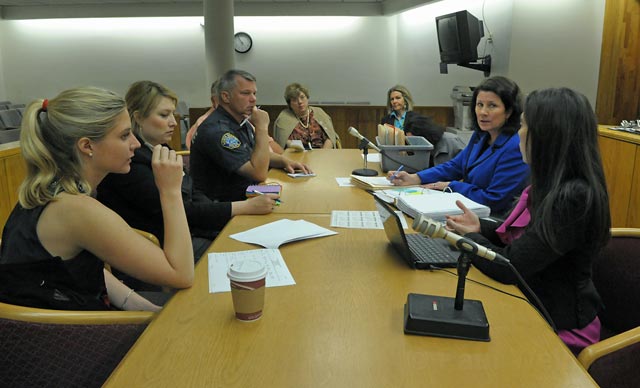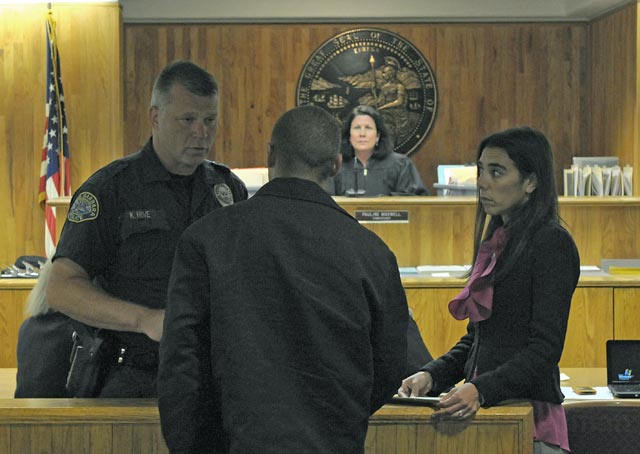Wrist Slaps Give Way to Helping Hands
Diversionary Program Steers Small-Time Homeless Offenders Away From Jail's Revolving Door

from right: Deputy Public Defender Jennifer Archer, Commissioner Pauline Maxwell, Jail Discharge Planner Tona Wakefield, mental health expert Norma Benavides, Restorative Policing Officer Keld Hove, attorney Emily Allen, and intern Lauren Volkmann.
Every Wednesday morning, Santa Barbara Restorative Policing Officer Keld Hove takes a seat at a large table in Department Seven of superior court. To his right sits the courtroom’s poised and quietly upbeat commissioner, Pauline Maxwell. Opposite him is Deputy Public Defender Jennifer Archer and eight or nine seasoned professionals from the fields of mental health, social work, and legal aid.
This is Restorative Court (RC), the 11-week-old jail diversionary program for chronic offenders of minor municipal and state codes commonly associated with being homeless — offenses like illegal lodging, drunk in public, and drunk and disorderly that clog court calendars and burn through police resources faster than you can say freeze. Violent offenders and people charged with drug sales are not eligible.
Hove began last Wednesday’s staffing session with a report on his time with a mentally failing homeless man he’d escorted to a neurologist’s appointment at 7:30 a.m., “breaking” him out of jail with a court order that had fallen through the cracks, necessitating a flurry of late-night calls from Maxwell. The appointment was an accomplishment that had eluded the officer for months because, outside of jail, he could never find the man sober enough for an assessment. Now the group had a diagnosis and a way forward.
The conversation moved swiftly from case to case. There was an 18-year-old addict who wanted to leave town, a man who was supposed to have checked into sober living but was couch surfing instead. There was the situation of a homeless woman with bipolar disorder. The woman (whom we will call Joy) apparently has a penchant for mothering wayward homeless men while neglecting her own life and sleeping on the beach. She was recently issued a ticket for illegal lodging.
“Can she go into the Hotel de Riviera track?” asked a social worker from Alcohol, Drug and Mental Health Services. “She’d never go there — too many people,” replied a mental health provider from Justice Alliance who had already met with Joy.
“How long would it take for her to get Social Security Disability Insurance?” asked someone of Tona Wakefield, the jail discharge planner from Bringing Our Community Home, which works to move the most vulnerable homeless people into supportive housing. Wakefield shakes her head. “Three months at least.”
A plan is teased out. Joy will be given a mental health evaluation, access to medication, and help applying for General Relief while options for housing are explored by the team. All of this will be provided in a six-month case-management plan Joy has to agree to with a signature. If she keeps to the terms, her ticket will be dismissed. But the real hope is that, when housed, she and others like her will stop offending, take medication, and regain some stability.

After the staffing hour, Maxwell puts on her judicial robes, and about 12 participants (not defendants) are brought before her individually for a check-in. “Mr. Nype, I hear good things about you,” says Maxwell to a man in a suit and tie who is one week out of jail, sober in a treatment program. “You’re doing so well I’m not going to have you come back here every week.”
Restorative Court was launched in March after 10 months of planning meetings and seven years of dreaming on the part of senior judges, legal advocates, probation officials, county supervisors, and the City Attorney’s office. The meetings were collaborative, though many officials looked to Hove for guidance and leadership; the program, after all, targets the people he works with day in and day out. Equally influential was Maxwell, who, as a research attorney, investigated the court’s initial interest in launching a Homeless Court — a system of resolving tickets and fines through community service. But Maxwell, Hove, and others wanted something that would encourage more permanent changes, changes that would keep people off the court calendar, out of jail, and alive.
In January, Maxwell, who was a nurse before becoming an attorney, told the planning group, “We’re never going to iron out all the kinks; let’s just go.” With an opening in her calendar, and an interest in the population, the program became hers to run with.
“This court isn’t in any [political] camp. It’s a win-win situation for everybody, because what we’re doing both ends the waste of resources and gets people off the street,” she said. Given the recent Grand Jury report on the recycling of mentally ill homeless through the jail, the timing could not be more apt.
Completely voluntary, the court started out with 10 people picked mostly by Hove but has grown to a vacillating flock of about 40. Now, Hove and Archer, who is present in arraignment daily, both select candidates. But it’s Hove who has the final say on whether or not someone is a good RC candidate. He’s the big boss, with the instincts to spot whether a person is truly ready to, as he puts it, “try something different.” In the end, Restorative Court is a function of Restorative Policing, and Restorative Policing is vital to Restorative Court.
“It’s hard to say what motivates people,” Hove said of his work with people who are on the street because of addiction, illness, or both. “Sometimes I catch that it’s the judge, that they’re supposed to be in front of a judge at a certain time,” he said of the structured environment that some find appealing and encouraging. In any case, he said, the court has taken Restorative Policing and put it into turbo drive, giving him a way to set small, tangible goals for people.
Still, some look at their case management plan and say, “This isn’t for me.” Others, like Morris (not his real name), see it as a hand reaching down from a bank of fluffy white clouds. Homeless and mentally ill, Morris had a maddening habit of lying down in the middle of the street as night fell. When confronted with his antics, Hove had no alternative but to arrest him and cart him to jail, though both men knew this was exactly what he wanted. Jail was a warm, safe bed for a man with no capacity to cope with homelessness.
In Restorative Court, Morris signed a case management plan that kept him in jail until a bed became available in a subsidized facility with support services. With Public Defender Archer’s blessing, Morris stayed there for weeks, waiting for a room to open up somewhere. And one did, this week. Now, with medication, a room, and someone checking on him from time to time, the people around the table in Department Seven are betting Morris will stay out of the road.



